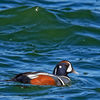Banding in sky: Help!
Aug 26, 2017 09:36:46 #
Rongnongno wrote:
I do not see any banding but clumsy attempts to hide defects in the capture.
Checking for defects... No banding.
.
Checking for defects... No banding.
.
I agree and I also see other "artifacts" in the image, such as those made by dirt on the camera sensor.
Aug 26, 2017 09:42:18 #
flyguy wrote:
I agree and I also see other "artifacts" in the image, such as those made by dirt on the camera sensor.
An ounce of prevention (routine checking and cleaning sensor) is worth a pound of cure (time-consuming spot removal).
Aug 26, 2017 10:27:14 #
mdfenton wrote:
On my monitor --- I have clear blue-sky in a photo showing bands, each about a sixteenth-inch wide, extending about 1 1/2 inch away from the edge of the photo. It looks like a comb was dragged across the sky from the photo edge. There is a subtle change in blue hue between bands. I see it at 17% to 50% magnification, but not beyond 50% to 100%. I don’t know whether these bands would show in a print. Would anyone care to guess what this banding is? Is it noise? Many thanks.
The cause for this is usually because the image has been reduced to an 8-bit image. In other words, a jpg image. Sometimes an image that is raw and edited down to a jpg and/or 8-bit image will show banding. It's always best to shoot in raw. If you edit your image and see that banding is taking effect, then make sure you retain 16-bit properties of the image and try not to drastically edit the sky or the part that is banding.
Aug 26, 2017 12:27:33 #
mdfenton wrote:
The banding is along the left border. Can't be seen above.
Banding is not visible at any magnification on my iPhone 7+. Try a different monitor.
Aug 26, 2017 12:38:47 #
mdfenton wrote:
On my monitor --- I have clear blue-sky in a photo showing bands, each about a sixteenth-inch wide, extending about 1 1/2 inch away from the edge of the photo. It looks like a comb was dragged across the sky from the photo edge. There is a subtle change in blue hue between bands. I see it at 17% to 50% magnification, but not beyond 50% to 100%. I don’t know whether these bands would show in a print. Would anyone care to guess what this banding is? Is it noise? Many thanks.
Hi again MDF - I think Rongnono got it right in his last post. I hope you have a RAW of this - The pic is too good to lose. In the event that you have - I suggest that you start again, taking account of comments made.

Aug 26, 2017 14:40:27 #
Aug 26, 2017 14:46:34 #
LoneRangeFinder wrote:
I keep hearing talk about cleaning sensors, but in ten years of digital photography, only once have I had a spot on a sensor, and the camera's built-in cleaning removed it. I'm a believer in "first do no harm" and I don't see any reason to touch a sensor unless you know you have a problem which can be addressed by no other means.An ounce of prevention (routine checking and cleaning sensor) is worth a pound of cure (time-consuming spot removal).
Aug 26, 2017 17:24:18 #
mdfenton wrote:
On my monitor --- I have clear blue-sky in a photo showing bands, each about a sixteenth-inch wide, extending about 1 1/2 inch away from the edge of the photo. It looks like a comb was dragged across the sky from the photo edge. There is a subtle change in blue hue between bands. I see it at 17% to 50% magnification, but not beyond 50% to 100%. I donâÂÂt know whether these bands would show in a print. Would anyone care to guess what this banding is? Is it noise? Many thanks.
Hi, when shooting a JPG photo banding or posterization can occur, mainly in the sky area. In the image that you posted, from what I can see, there is no banding or posterization. That is not to say that the image does not have some problems that I can see. I have circled some areas where there are problems (very smooth areas with no detail in the sky areas for the most part) in the image, mostly in the sky area. I will make no attempt to say why they are there as that seems to have been covered by some others. You might want to take a look at the image and determine what happened in the circled areas. Look up banding; there was an article I ran across that talked about the difference between banding and posterization that occurs from processing and how to help that in Photoshop. The image also looks as if there might not have been sufficient light and that has affected the quality of the image. It's difficult to determine what has occurred in this type of setting. Perhaps you should start all over with the original shot and see if you can process it a bit differently with a different outcome. Nice photo, overall.
Aug 26, 2017 21:30:03 #
Rongnongno wrote:
If you folks believe that ignoring the truth of wh... (show quote)
You can't edit and correct what you can't see. . .
Aug 26, 2017 21:31:32 #
rehess wrote:
I keep hearing talk about cleaning sensors, but in ten years of digital photography, only once have I had a spot on a sensor, and the camera's built-in cleaning removed it. I'm a believer in "first do no harm" and I don't see any reason to touch a sensor unless you know you have a problem which can be addressed by no other means.
And I have to clean my sensors every 6 to 9 months. . .
Aug 26, 2017 21:48:41 #
via the lens wrote:
Hi, when shooting a JPG photo banding or posteriza... (show quote)
Hey there: you might ALSO try a "de-noise" filter setting and see if it nixes any of the problem areas. (I agree with the initial low light guess or possibly the contrast settings were overdone on the other issues).
Aug 28, 2017 14:12:59 #
I don't believe this is banding. This looks more like smudges on your sensor or the back side of your lens.
Aug 28, 2017 14:13:23 #
Just paint in the sky color in Photoshop with the Gradient tool, add a little noise to match your shot and be done with it. Not a complicated sky just very subtle shades of color. But first, I would change the mode to 16-bit so the blend doesn't band again. When you get it right you can flatten it back to 8-bit.
If you want to reply, then register here. Registration is free and your account is created instantly, so you can post right away.











